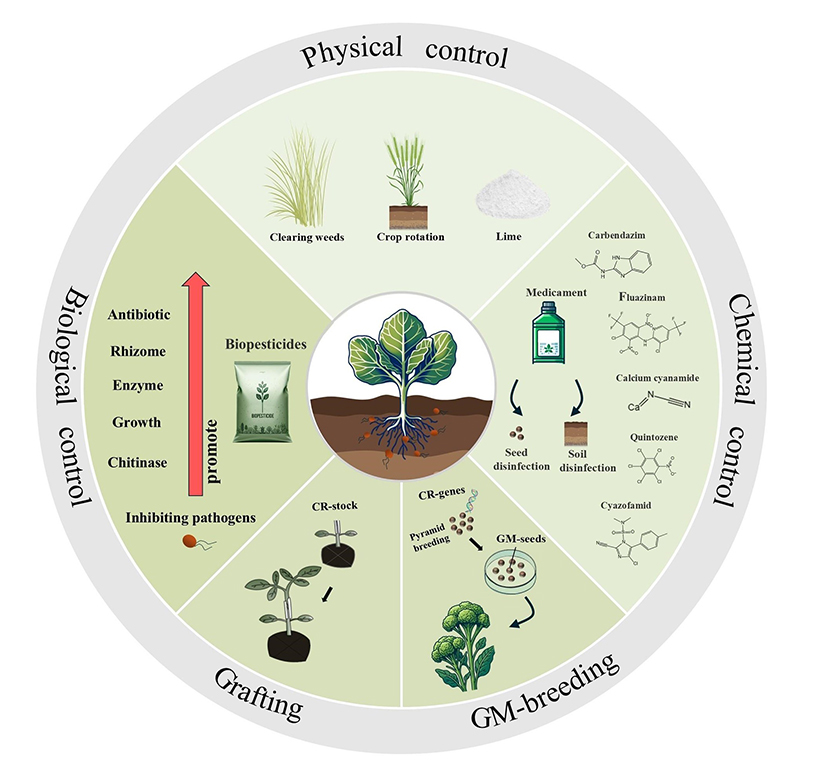Recently, the Cabbage and Broccoli Research Group at the Institute of Vegetables and Flowers, Chinese Academy of Agricultural Sciences, published a comprehensive review article titled "Clubroot Resistance in Cruciferous Crops: Recent Advances in Genes and QTLs Identification and Utilization" in the internationally renowned journal Horticulture Research (Impact Factor = 7.6), a top journal in the field of horticulture.

Cruciferous crops represent one of the most widely distributed groups of economic crops worldwide, encompassing both fresh vegetables and oilseed crops such as rapeseed, mustard, cabbage, Chinese cabbage, broccoli, cauliflower, and kale. They hold an important position in global agriculture. However, these crops are prone to various diseases, among which clubroot is one of the major and destructive diseases. Characterized by its wide spread, strong pathogenicity, and difficulty in control, clubroot severely limits the stable and high-yield production of cruciferous crops globally.
Clubroot is a soil-borne disease caused by Plasmodiophora brassicae, an obligate parasite that infects cruciferous crops. The widespread practice of monoculture and large-scale continuous cropping, combined with the pathogen’s highly resilient resting spores that can survive in soil for extended periods, has intensified the long-term impact of this disease. Developing resistant cultivars remains the primary strategy for mitigating losses; however, this approach faces fundamental challenges, including lengthy breeding cycles, a lack of broad-spectrum resistance, poor resistance durability, and the frequent breakdown of resistance. At present, there is a lack of major genes and core immune mechanisms that can confer durable and stable resistance.
This review explores the genetic basis of clubroot resistance in cruciferous crops and the population-level diversity of resistance traits. It highlights various breeding strategies and their applications, including marker-assisted selection (MAS) and CRISPR/Cas9-based genome editing. In addition, it presents integrated control strategies from multiple dimensions, such as physical, chemical, resistant rootstocks, transgenic approaches, and biological control methods, offering a comprehensive framework for disease management. These technologies are accelerating the development and utilization of elite resistant germplasms. Furthermore, the review summarizes the major resistance genes identified to date and discusses potential strategies to combat the persistent threat of clubroot. The article provides valuable theoretical insights and a scientific foundation for better understanding the genetic mechanisms underlying clubroot resistance and for promoting the efficient use of resistant germplasm resources in cruciferous crops.

Figure 1. QTL mapping of CR (Clubroot Resistance) loci in cruciferous crops.
(a) BSA (Bulked Segregant Analysis), (b) GBS (Genotyping-by-Sequencing), (c) QTL (Quantitative Trait Loci) analysis.

Figure 2. Integrated control strategies for clubroot disease in cruciferous crops.
Mr. Shangxiang Lai, a jointly trained master's student of the Institute of Vegetables and Flowers, Chinese Academy of Agricultural Sciences (CAAS), and the College of Horticultural Science, Zhejiang A&F University, and Dr. Yunshuai Huang, a young faculty member of the College of Horticultural Science at Zhejiang A&F University, are co-first authors of the paper. Researcher Zhansheng Li is the corresponding author, and the Institute of Vegetables and Flowers, CAAS, is the corresponding institution. This work was supported by the National Natural Science Foundation of China (Grant No. 32172580), the National Agricultural Science and Technology Innovation Program (ASTIP), and the China Agriculture Research System (CARS-23-A05).
Paper link:https://doi.org/10.1093/hr/uhaf105